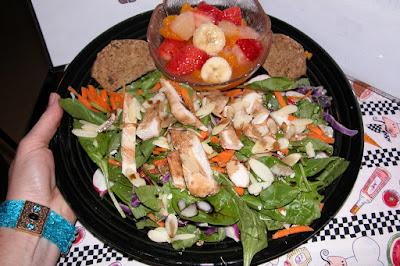I spent much of my career in retail services, working as a manager for the university hospital. In the early 90s, the focus was on changing the institutional image to one of retail. Employees wore chef coats and hats to carve turkey and beef on the serving line.
Cakes were baked in round pans and cut in wedges instead of squares. The made to order deli line with carved bread was a popular station.
"Individual" round pizzas were baked in a conveyor oven at service. Stainless steel serving containers were replaced with black bowls and pans. Stainless steel tables were covered with linen.
I was fortunate to work in health care where fruits and vegetables were always encouraged. Most of the entrees were made from scratch. In the low fat era of the 90s, we served lots of boneless skinless chicken breasts. We offered daily selections of low fat desserts, even reducing the added sugar. Whole grains were limited to whole wheat bread on the deli with white rice and pasta the staples. The jumbo craze extended to muffins and bagels-like the "individual" pizzas, 2-3 times the recommended serving size, with little fiber.
We purchased our first espresso machine which proved to be so popular, it now has it's own cafe. A panini machine was added to the deli in the snack bar.
The 90s brought layoffs in the supervisory staff. When I moved to the Health Sciences Center in 1997, I went solo. The merchandising skills I'd learned proved valuable when improving the surroundings in the run down 50 year old cafeteria. Customer service was the focus in eliminating the 1/2 hour cafeteria shut down between breakfast and lunch, the same time the facilities staff took their lunch break.
In the 19 remaining years I managed that cafeteria, I blended my nutritional knowledge with the service and merchandising skills. Every year I made a change, based on current nutritional recommendations, to encourage customers to make healthy selections. What I'd learned is that doesn't just focus on the menu, but also the service and the surroundings.
It was in the 80s when local restaurateur, Joe Sesisto, shared his Vegetable Lasagna recipe with us. It was one of many heart healthy recipes the American Heart Association endorsed. Well into his 90s, he came back to share that recipe with us. I did not save but a few from my 37 years at the hospital, but this one was a keeper because his memory I want to cherish.
Joe's Vegetable Lasagna
(Serves 12)
10 each uncooked lasagna noodles
12 ounce zucchini, sliced and quartered
8 ounce carrots, sliced in rounds
4 ounce green peppers, 2 inch strips
1 pound whole tomatoes, cubed
6 ounce cauliflower, 1/4 inch slices
6 ounce broccoli, 1/4 inch slices
1 pound low fat cottage cheese
12 ounce part skim mozzarella cheese
1 pound 12 ounce pizza sauce
3 3/4 ounce Parmesan cheese
Spray no-stick product on baking dish. Place a layer of noodles on bottom of
pan. Arrange the following in layers in
the pan. 1 cup cauliflower, 1 cup
carrots, 1 cup tomatoes, ½ cup peppers, 1
½ cup broccoli, 1 ¼ cup zucchini, ¾ cup cottage cheese, ¾
cup mozzarella cheese, 1 ½ cups pizza sauce, ½ cup Parmesan cheese. Add another layer of noodles and repeat step
# 3. Cover pan with foil which has been
sprayed with no-stick product. Bake at
350 degrees for 1 ½ hours. Cut lasagna 3
x 4 and serve.

















